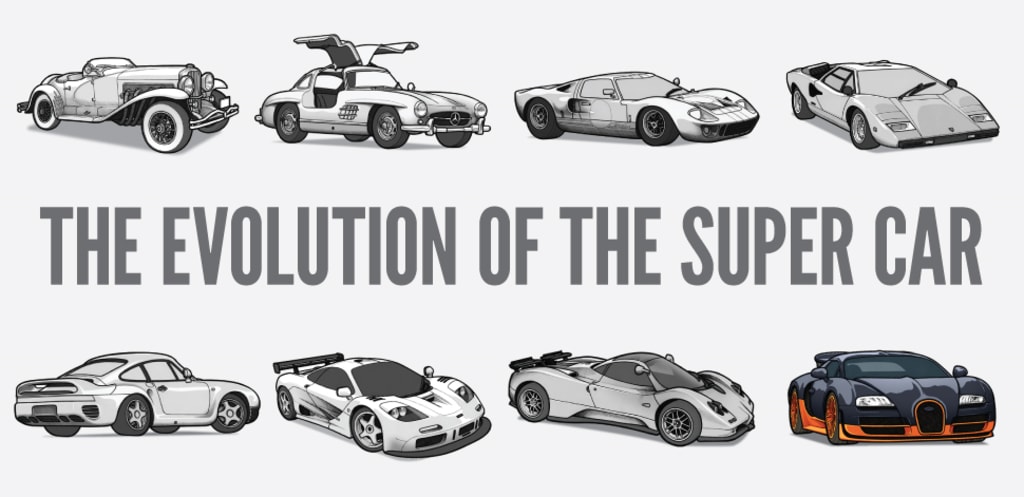The History of Supercars
From the beggining until now

A supercar – also called exotic car – is a loosely defined description of street-legal, high-performance sports cars. Since the 2010s, the term hypercar has come into use for the highest performing supercars. Supercars commonly serve as the flagship model within a vehicle manufacturer's line-up of sports cars and typically feature various performance-related technology derived from motorsports. Some examples include the Ferrari 458 Italia, Lamborghini Aventador, and McLaren 720S.
In the United States, muscle cars were often referred to as "supercars" during the 1960s.
Europe
The Lamborghini Miura, produced from 1966–1973, is often said to be the first supercar. By the 1970s and 1980s the term was in regular use, if not precisely defined. One interpretation up until the 1990s was to use it for mid-engine two-seat cars with at least eight cylinders (but typically a V12 engine), a power output of at least 400 bhp (298 kW) and a top speed of at least 180 mph (290 km/h). Other interpretations state that "it must be very fast, with sporting handling to match", "it should be sleek and eye-catching" and its price should be "one in a rarefied atmosphere of its own" or regard exclusivity (i.e. limited production volumes) as an important characteristic (such as those made by Ferrari or Lamborghini).
It is also claimed that the definition of a supercar has always been subjective and a matter of blind prejudice.
United States
During the 1960s, cars that are now considered to be muscle cars were then referred to as supercars. The term was sometimes spelled with a capital S. In 1966 the sixties supercar became an official industry trend. For example, the May 1965 issue of the American magazine Car Life includes multiple references to supercars and "the supercar club" and a 1968 issue of Car & Driver magazine refers to "the Supercar street racer gang" market segment. In the model name of the AMC S/C Rambler, the "S/C" is an abbreviation for "SuperCar".
Since the decline of the muscle car in the 1970s, the word supercar came to mean a car that has high performance interpretations of the term are for limited-production models produced by small manufacturers for enthusiasts, and, less so, standard-looking cars modified for increased performance.
Hypercar
A more recent term for high-performance sportscars is "hypercar", which is sometimes used to describe the highest performing supercars. As per supercars, there is no set definition for what constitutes a hypercar. An attempt to define these is "a limited-production, top-of-the-line supercar with a price of around or more than US$1 million."
Some people consider the 1993 McLaren F1 to be the first hypercar, while others believe the 2005 Bugatti Veyron was the first hypercar.
With a recent shift towards electrification, many recent hypercars use a hybrid drivetrain, a trend started in 2013 by the McLaren P1, Porsche 918 Spyder, and LaFerrari, then continued in 2016 with the Koenigsegg Regera, in 2017 with the Mercedes-AMG One, and in 2019 with the Ferrari SF90 Stradale and McLaren Speedtail.
Modern hypercars such as Pininfarina Battista, NIO EP9, Rimac Nevera, and Lotus Evija have also gone full-electric.
Hypercars will also be able to be used as a base for Le Mans Prototype cars when rule changes come into effect from 2021.
So summarily
1950s
The term 'supercar' was first used in the 1920s, but it wasn't until the mid 1950s that high performance sports cars began to appear.
1960s
Supercars as we know them arrived in the mid 1960s with the motorsport derived Ford GT, born out of Ferrari's refusal to become part of Ford.
But perhaps the first genuine supercar was Lamborghini's mid-engined Miura, designed from the outset as a road car.
1970s
The fuel crisis of the early 1970s almost killed off the supercar before it had really began.
Thankfully we were treated instead to the birth of the definitive supercar of a generation, the Lamborghini Countach.
The 70s also saw the first mass market turbo road cars, notably the BMW 2002 and classic Porsche 911 Turbo.
1980s
The Financial boom of the 1980s saw supercar values soar, leading in turn to the birth of the low volume, super exclusive hypercar market.
Starting with Ferrari's Group B inspired 288 GTO, the decade was rounded off with the legendary rivalry between Porsche's technology led 959 and Ferrari's F40 road racer, the first 200mph road car.
This is also when the Nurburgring first came to our attention, thanks to the legendary exploits of the RUF CTR 'Yellowbird'.
1990s
The 90s began with a very significant car, the Honda NSX. This showed for the first time that supercars could be civilised, easy to drive and reliable.
Hypercar development continued through the decade with notable cars from Jaguar, the re-emergance of the Bugatti name and probably the world's first super saloon the 175mph Lotus Carlton.
However, there is one car that outclasses them all, setting new levels of exclusivity and performance (240mph in 1994), remaining many peoples pick as the greatest supercar of all time, McLaren's legendary F1.
2000s
The 2000s saw two differing approaches to performance. Track focused companies such as Ariel, Radical and Ultima taking the light weight route, while the likes of Ferrari and Porsche, joined by newcomers Pagani and Koenigsegg, went for all out power.
They were all trumped in 2005, with the arrival of the awesome Bugatti Veyron. Blowing away even the F1's figures from just a decade ago, the 1000bhp Veyron was the first car to break 250mph and hit 0-60mph in just 2.5 sec.
This decade also saw the shape of things to come, with the introduction of the world's first electric sports car, the Venturi Fetish, closely followed by Tesla's Roadster.
This is also when we see the emergence of the now ubiquitous super SUV, headed by Porsche's Cayenne. Thought of as a bold move at the time, even Bentley, Maserati and Lamborghini are now in on the act.
2010s
We are now in a 'golden era' for supercars. Never before have their been so many high performance models from so many manufacturers.
The 2010s have seen the birth of a new breed of supercar with hybrid or fully electric engines.
The so called 'Holy Trinity' of the McLaren P1, Porsche 918 Spyder and Ferrari LaFerrari hybrid hypercars set new levels of performance with relatively green credentials.
There are still plenty of 'old-school' supercars around though, with the likes of the Koenigesgg One:1, Henessey Venom GT and Bugatti's 1500hp Chiron vying for title of the world's fastest car.
However, the future of performance cars is without doubt electricity. Rimac and Tesla have shown us that the instant torque of a 4WD electric motor is more than a match for even the most powerful internal combustion engines.
Aerodynamics and lightweight construction also play a big part, with Ford's 2017 GT, Porsche's 911 GT2 RS and Lamborghini's Huracan Performante all utilising state of the art aero to achieve previously unimaginable track times.
But even before the end of the decade, Mercedes and Aston Martin have again moved the goalposts with the introduction of their F1 inspired race cars for the road, and Bugatti became the first to crack the 300mph barrier with the Chiron Super Sport 300+.
Here's to 50 years of the supercar. Long may it continue!
About the Creator
Codrin Dumbravă
Nothing here, just everything I want to post.






Comments
There are no comments for this story
Be the first to respond and start the conversation.